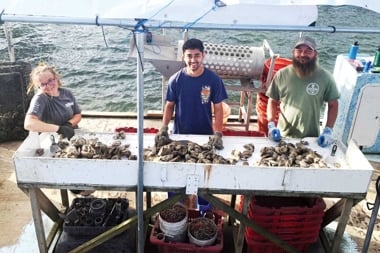Our Toxic Nation

More than 23,000 chemicals are registered for use in Canada and each year this number grows. Obviously, some exposures we can't prevent. But every attempt is worthwhile, says Environmental Defence (ED), a Toronto-based organization that has recently released eye-opening data on the chemical burden we face.
What do you get with a pot, a stove, kernels, a little oil, and a lot of shaking? A bowl of fresh popcorn. And what don’t you get? A possible dose of suspected cancer-causing perfluorinated chemicals that coat the inside of microwaveable popcorn bags.
Stove-popping is just one way to avoid contact with the countless chemicals that we’re exposed to daily. More than 23,000 chemicals are registered for use in Canada and each year this number grows. Obviously, some exposures we can’t prevent. But every attempt is worthwhile, says Environmental Defence (ED), a Toronto-based organization that has recently released eye-opening data on the chemical burden we face.
Polluted Children, Toxic Nation
Two years ago, Toxic Nation: A Report on Pollution in Canadians found that 11 participants had an average of 44 of 88 tested chemicals in their bodies. The group’s second study, Polluted Children, Toxic Nation, published last June, is even more groundbreaking because it’s the first to assess pollution levels in Canadian youths, an especially vulnerable population.
“Studies in other countries showed kids were more toxic in certain chemicals than adults. Likewise in our study, stain repellent and flame retardant chemicals were higher in children,” says Sarah Winterton, program director of ED.
A Chemical Burden
Blood and urine samples from 13 people in five cross-country families were tested for 68 chemicals. Forty-six chemicals were detected, including five PBDEs (polybrominated diphenyl ethers, as flame retardants), 13 PCBs (polychlorinated biphenyls, in electrical transformers and now banned), five PFCs (perfluorinated chemicals, in stain repellents, nonstick cookware, and food packaging), nine organochlorine pesticides, four organophosphate insecticide metabolites, five PAHs (polycyclic aromatic hydrocarbons, in everything from tobacco smoke to vehicle exhaust), and five heavy metals.
This is not just a huge syllable headache. These acronyms represent 38 carcinogens, 23 hormone disruptors, 38 reproductive and developmental toxins, 19 neurotoxins, and 12 chemicals associated with respiratory illness. Toss in another three PFCs for which there is no known health data and we’ve got a suspiciously ominous brew–not to mention a good argument for stronger national chemical and consumer protection laws.
Health Canada has publicized their intention to do a larger-scale study this year, but requests for official feedback on the ED studies were declined.
“A big criticism was that it wasn’t a huge sample size,” says Winterton. “But we chose volunteers from different areas of the country, different ages and occupations. It was very easy to put that [criticism] to rest. Find me a person who isn’t contaminated.”
A Motivated Mother
When Patty Donovan of Quispamsis, New Brunswick, was invited to participate in the study last year, she doublechecked with her twin daughters, Hanna and Mary, then 15. “They thought it was cool because it was going to help other people know what’s in us, and that way, we can stop putting it in us,” she recalls.
The program facilitator at a women’s centre and a self-described pesticide activist, Patty is no stranger to chemical toxicity. Eleven years ago, her son Zack got sick from chemical cleansers used at his elementary school. What followed were years of on and off homeschooling, helping him to reclaim his health, reteaching him how to read and write, and campaigning to make New Brunswick’s schools healthier spaces.
Her family has eaten organically since they were tots in diapers. Their house is chemical-free, with baking soda and vinegar the nontoxic cleansers of choice. So when study results showed her daughters had the lowest levels of contaminants of any participants across the country, she didn’t feel shocked so much as vindicated.
“I’ve been able to stand a little straighter,” she says. “When I used to say to my [extended] family, ‘Get that crap out of your house, those are carcinogens,’ they looked at me and said, ‘Oh, crazy Patty.’ But the proof is in the pudding. Here are the blood tests to prove it.”
Among study participants, an average of 32 chemicals were found in parents and 23 chemicals were found in children. The Donovan twins, however, had fewer than average. Patty’s body had only 24 of the tested chemicals.
Little did they know how significant those tests would become. Shortly after participating in the study, young Mary was diagnosed with aplastic anemia, a serious blood disorder affecting three out of every million people. The body stops producing enough red blood cells, causing fatigue, higher risk of infection, and uncontrolled bleeding. Aplastic anemia is linked to genetic disposition and viral and environmental contaminants. In Mary’s case, her
doctors couldn’t definitively state the cause but were able to use her data to better understand her health situation.
“I said to them, ‘I can tell you what pesticides and chemicals are in her body, and how much.’ They were shocked. Most parents don’t come to the table with that information,” Patty recalls.
Since then, Mary’s treatment plan has included blood transfusions and drug therapy. They’ve found a bone marrow donor for a transplant that will take place following chemotherapy and total body radiation. Meanwhile, the Donovans have tried to stay
positive and are more outspoken than ever about the need for chemical awareness and reduction. Despite having to head to hospital with Mary in less than two hours, Patty took time away from packing to conduct a phone interview with me.
Medical and Chemical Crusaders
Patty’s highly motivated attitude is one ED wishes for all Canadians. “We’re urging people to pay more attention to what they’re purchasing,” says Winterton. “How important is it really to have stain repellent on your couch? There’s a price to all this convenience that people are buying into without questions.”
The group is calling for changes to the Canadian Environmental Protection Act (CEPA), including aggressive guidelines for the elimination of toxic chemicals–at the minimum, a 50-percent reduction by 2010, and virtual elimination by 2015. Last fall the federal government announced that 4,000 chemicals in Canada pose enough risk to human health or wildlife to merit in-depth safety studies. Environment Canada and Health Canada have started what they’re calling the most comprehensive review ever.
Environmental Defence also wants to shift the burden of proof for safety to industry, which currently isn’t required to prove a chemical is safe before it is used in products. And as history shows, banning or strictly regulating a toxic chemical once it’s on the market takes a long time.
Case in point: The pesticide DDT (dichlorodiphenylthrichloroethane), which author Rachel Carson documented in Silent Spring in 1962 as the cause of birth defects and cancer, wasn’t banned in Canada until 1990. Even now, DDT is used in other countries. In September 2006, the World Health Organization raised controversy by promoting its use to combat malaria in Africa and, critics argue, effectively undermining an existing global treaty calling for a phaseout.
In the Polluted Children, Toxic Nation report, PCBs–banned in Canada in 1977 before the study’s kids were born–nevertheless showed up in all parents and children. Generally, though, kids possessed fewer and lower levels of contaminants, suggesting that governmental action to eliminate toxic chemicals does work over time.
Time to Clean House?
In the meantime, there’s no better place to purge than our homes. The ED website (environmentaldefence.ca) has a helpful interactive feature that offers suggestions on less toxic replacements people can use in various rooms.
Even reading whatever labelling is on personal care products is a start. According to the latest Toxic Nation report, by the time a woman finishes her morning grooming, she’s doused herself in an estimated 126 chemicals.
“Maybe it feels overwhelming,” says Winterton, “and it is overwhelming. But you can do one or two things that you know are going to reduce your exposure. We think that will help.”
Summary Results from Toxic Nation: A Report on Pollution in Canadian Families
Number of Chemicals Detected in Study of 11 Volunteers
| Chemical group | Number of chemicals tested | Total number of chemicals detected | ||
| In adults | In children | In all volunteers | ||
| Heavy metals | 5 | 5 | 5 | 5 |
| PBDEs | 5 | 5 | 5 | 5 |
| PCBs | 16 | 13 | 10 | 13 |
| PFCs | 13 | 5 | 4 | 5 |
| Organochlorine pesticides | 13 | 9 | 7 | 9 |
| Organophosphate insecticide metabolites | 6 | 4 | 3 | 4 |
| PAHs | 10 | 4 | 5 | 5 |
| Total | 68 | 45 | 39 | 4 |
Health Effects of Chemicals Found in Volunteers
| Health effect | Number of chemicals detected that are linked to listed health effect | ||
| Total | In adults | In children | |
| Carcinogen | 38 | 37 | 33 |
| Hormone disruptor | 23 | 23 | 23 |
| Respiratory toxin | 12 | 11 | 11 |
| Reproductive or developmental toxin | 38 | 37 | 37 |
| Neurotoxin | 19 | 19 | 17 |
| No data on health effects | 3 | 3 | 2 |
Source: Polluted Children, Toxic Nation: A Report on Pollution in Canadian Families (environmentaldefence.ca)




